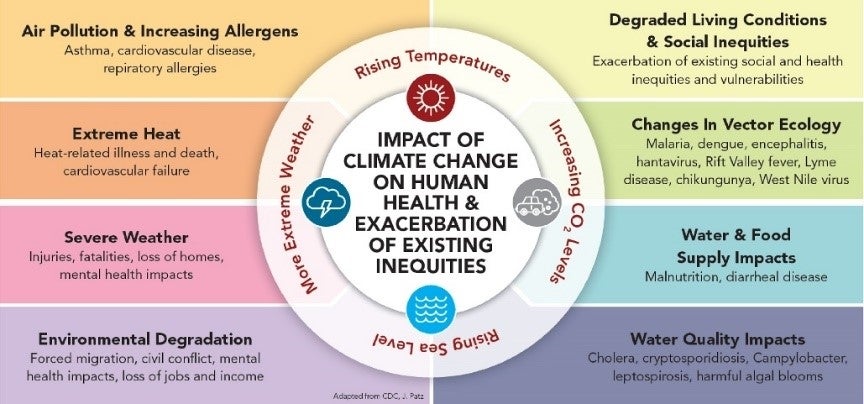Climate Health
Climate Health
Fostering healthy places by shaping healthier and more resilient communities.
The greatest increase in the number of high heat days from 1995 to 2070 are projected to occur in Atherton, East Palo Alto, Foster City, Menlo Park, North Fair Oaks, and Redwood City.1
In September 2019, the San Mateo County Board of Supervisors declared a climate emergency. This resolution aims to accelerate the local and regional response to address climate change. Climate change is expected to affect all populations but specifically vulnerable populations such as children, elderly, those with preexisting physical conditions, and low-income and communities of color. Because of this disproportionate impact on these sectors of the population, climate change will exacerbate existing health inequities.
Health Connection
A healthy climate promotes health by ensuring we enjoy fresh air, water, food, and healthier ecosystems, and that we experience less disruptive weather systems that impact day-to-day activities like access to jobs, schools, hospitals, and grocery stores.
-
Sea level rise negatively impacts essential infrastructure such as roads, wastewater and energy plants, and healthcare facilities that we need to run day-to-day activities.2 Consequently, human health can be impacted by sea level rise by causing forced migration, exacerbating mental health stressors caused by loss of jobs and income, increasing risk of cholera, and harmful algae blooms that contaminate water.3
- The San Mateo County Climate Action Plan estimates that 110,000 San Mateo County residents, that is 14% of the total population, live in areas vulnerable to 100-year flood event with a 1.4-meter rise in sea level.4
-
Extreme heat weather due to climate change
impacts human health by increasing the risk of heat exhaustion
and heat related illnesses such as heat strokes and premature
death.
- Based on the San Mateo County Office of Sustainability’s Extreme Heat Factsheet, the average high temperature is projected to increase for the years 2030 and 2070 for all jurisdictions in the County. By 2050, ten days or more of a given year could have temperatures above 90°F, which could lead to an increase in the risk of heat related illnesses.
-
Droughts increase health hazards through the
lower availability of water supplies and increased risk of
wildfires. As such, intense wildfires impact watersheds and
increase the possibility of flash floods. Wildfire smoke and
dust storms increase respiratory cardiovascular
hospitalizations, asthma, and chronic obstructive pulmonary
disease. Droughts could also impact mental health due to
increased stress and sadness because of temporary displacement
and loss of homes and/or jobs.5
- According to the 2021 Multijurisdictional Local Hazard Mitigation Plan (2021), the county has a high probability of continuing to experience multi-year, severe droughts every five to six years on average.
Climate change exacerbates health inequities. The impacts of climate change do not affect all communities in equal proportions. Communities of color, children, older adults, and low-income communities are more vulnerable to bear the burdens of climate events. Throughout San Mateo County, many vulnerable populations already live-in neighborhoods with poor air quality and housing conditions, less access to healthy foods, lack of green spaces, and limited tree canopy coverage. Residents who live in places that have less opportunity to make the healthy choice, the easy choice, experience higher health inequities. For example, a person living in East Palo Alto has a life expectancy about 5.5 years shorter than a person living in Atherton, a few miles away.6
Community resiliency efforts need to center vulnerable populations. The place-based and health inequities described above affect the ability of communities to prepare, respond and recover from climate disasters such as heat waves, floods, or wildfires. As such, equitable climate solutions must advance community-identified strategies to help us achieve health equity in our County. The importance of tackling climate change disasters for all communities, especially vulnerable populations, is not only a matter of climate justice but also health equity.
Resources
- Bay Area Regional Health Inequities Initiative (BARHII) Climate Resilience Initiative website includes a series of quick guides for public health practitioners who would like to learn more about the intersections of climate change and health equity.
- The California Department of Public Health crafted the Climate Change and Health Profile Report: San Mateo County (2017) to provide projections on different climate hazards and the impact of climate change on health outcomes.
- Climate Ready SMC is an initiative led by the County’s Office of Sustainability to help communities address climate impacts now and in the future. Climate Ready uses a variety of strategies to understand and plan for climate risks including fostering collaboration through webinars and convenings, modeling climate impacts; providing technical assistance, partnership, and funding for resiliency projects; and investing in culturally competent community engagement.
- The County recently adopted the Community Climate Action Plan that outlines actions to reduce greenhouse gas emissions.
- San Mateo County’s Multijurisdictional Local Hazard Mitigation Plan (2021) assesses local risk of climate change hazards and outlines a series of actions to mitigate the impact of climate change.
- The University of California Center for Climate, Health and Equity has multiple resources to help achieve health equity through climate initiatives.
Funding opportunities for community resilience and health
The State’s Integrated Climate Adaptation and Resiliency Program will be launching applications for three funding programs starting Summer 2022:
- The Adaptation Planning Grant Program expects to release request for proposals during the summer 2022.
- The Regional Resilience Planning and Implementation Program and the Community Resilience and Heat Grant Program guidelines will be expected to be released later this year.


